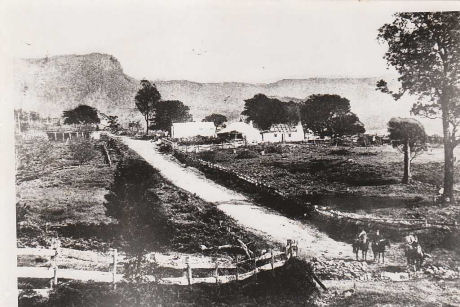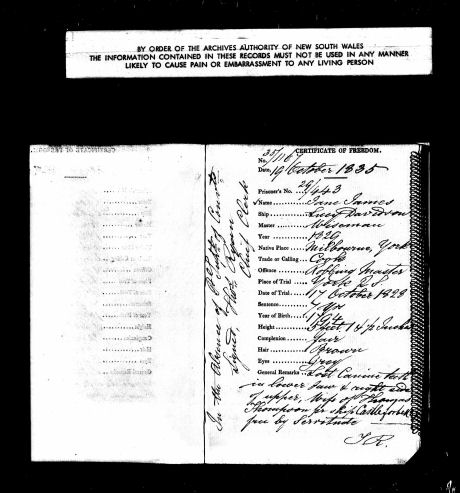|
The story of convict Jane James – a “wholesale plunderer” from Melbourne
By an Australian descendant
In November 1829 the ship Lucy Davidson arrived from England at Sydney Harbour, New South Wales, Australia, with 101 transported convicts on board. Among them was a Jane James aged about 35 whose native place on her eventual Certificate of Freedom was given as “Milbourne, York” and whose occupation was given as cook. She was recorded as 5 feet 1 ½ inches tall with brown hair and grey eyes who could read and write. She had been sentenced to seven years transportation beyond the seas in October 1828 at the York Quarter Sessions after pleading guilty to stealing at her places of employment. Her arrest and the subsequent investigation were reported in a number of articles in York newspapers.

Junction Old Illawarra Road & Yellow Rock Road Macquarie River 1800s
Reproduced with thanks to the copyright owner Shellharbour City Library Service
Arrest and investigation
The newspaper accounts of Jane’s arrest and investigation indicate that in about August 1827 she had been employed by a Mrs Brearey of Bootham, York, who ran a young ladies’ boarding school. Her mistress seems to appear as Mrs H A Brearey in the Pigots 1829 York directory of nobility, gentry and clergy at 17 Bootham. She was discharged from that employment in June 1828 and then went in search of work as a cook to a register office for servants run by Mrs Hannah Ward in Grape Lane. Around this time she was employed by Mr Joseph Backhouse, who may have been the tanner by that name who appears in Pigots 1829 directory at Lawrence Street.
In August 1828 Jane fell under suspicion of stealing linen from Joseph Backhouse. Her boxes were searched and items stolen from each of the three places referred to above were found, including items owned by the young ladies at Mrs Brearey’s school. The Yorkshire Gazette, calling her a “wholesale plunderer”, recorded just some of the items that were discovered:
- “[s]hawls, and almost every article of dress; silver spoons and forks, workbaskets, chimney ornaments, necklaces, a pack of playing cards, a box of dominoes, pocket-books, silver comb, brooches, rugs, pencil case, cotton box, nail, tooth, and hair brushes, nutcrackers, smelling bottles, hooks, finger glasses, glass dessert dish, china,— in short, nothing seemed to have come amiss to Jane”;
- “one large box, two small flat boxes, a hat box, a looking glass, umbrella, a small buffet, and doll’s cradle”;
- “one silver spoon, two caddy spoons, aromatic vinegar box, a silver whistle, small fancy pepper castor, a fancy egg and orange, a pocket-book, six napkins, &c”; and
- “[o]ne table-cloth, one dressing gown, one sheet, one pillow cover, one white gown skirt one slip, three pair cotton and one pair of silk stockings, one gown waist, one child’s pocket-handkerchief, one sugar basin, one dessert dish, two preserve dishes, three plated forks, four plated spoons, three pencil cases, one broach, &c”.
John Corner and Jane’s English children
In Jane’s boxes were also found letters from a John Corner, a blacksmith from Melbourne, Yorkshire East Riding, in which he acknowledged having received presents from her. During the investigation Corner said that upon hearing of Jane’s arrest he had taken a trunk of these presents to Jane’s mother at Melbourne, thinking they may have been stolen. He then, after seeking advice from General James Wharton of Rossmore Lodge in Melbourne (a veteran of the Waterloo campaign), retrieved them and turned them in to the authorities at York. He does not seem to have been prosecuted although he was initially remanded in custody.
John Corner stated that Jane was his “sweetheart” and that he had “followed” her for seven years. Jane’s convict records indicate that she had three children when transported and a witness during the investigation stated that one was nursing at the time. Sadly, Jane probably never saw them again. One of her three English children may have been an Elizabeth Jane Corner baptised on 27 November 1825 at Holy Trinity Kings Court, York, to a blacksmith John Corner and Jane, although it appears Jane never married John. One of Jane’s later Australian children was named Elizabeth Jane, perhaps in memory of her earlier daughter.
John Corner seems to have been born in August 1800 in Thornton parish and appears in the 1841 census at Melbourne with his wife Mary Corner nee Parker (who he married in 1834) and their daughters born from about 1836. He seems to have died in 1844.
Jane’s family background
Jane’s Australian death certificate states that she was the daughter of a William James. She fits very well with the baptism of a Jane recorded in Great Givendale parish on 19 August 1795 (born the day before) daughter of a William James, around then a labourer, and a Jane (found on familysearch.org). If so, her parents’ Great Givendale marriage on 1 April 1782 was recorded as follows: “William James farmer eldest son of Matthew James of Melburn a tailor aged 29 years of this parish and Jane Fugill aged 21 of this parish eldest daughter of John Fugill farmer of this parish.” William signed and his wife made her mark.
William James seems to have been baptised son of Matthew in Thornton parish on 20 July 1752 and according to his apparent death certificate died in Melbourne, a farmer aged 87, on 17 January 1840. William’s mother seems to have been a Jane Foster who Matthew James married in 1750 and who has a plausible line of descent in Thornton parish back to a baptism in 1652. Jane Fugill seems to have been baptised daughter of John in Great Givendale parish on 26 October 1760 and was described as being 74 and of Melbourne in her apparent 3 March 1835 St Michael’s, Thornton parish, burial record. Jane Fugill’s mother seems to have been a Mary Hare who John Fugill married in 1760.
The couple William James and Jane Fugill seem to have had nine children, including Jane, baptised in Great Givendale and Bishop Wilton parishes between 1782 and 1804. One son, Charles, seems to appear in the 1841, 1851 and 1861 censuses as a farmer of around 70 acres at Melbourne, and also appears to be recorded on the electoral roll at Melbourne in 1836 at a time when only the well-to-do could vote (indicating the family’s decidedly mixed fortunes). He died in 1867. Two other sons, William and John, may have been buried at St Michael’s in 1830 and 1834 respectively, both leaving wills (although this author has not seen them) and both being described as of York in the burial register. They were buried on the same date, 7 February, in their two separate years of death.
Jane’s convict years
Upon arriving in the colony of New South Wales, Jane was assigned to work for Mr Archibald Bell of Windsor to the north-west of Sydney, either a prominent ex-soldier and magistrate or his son by the same name, a noted explorer. In 1830 she and an ex-convict Thomas Thompson applied to be married, but the application was cancelled. Thomas, who arrived on the Castle Forbes in 1824, was a Catholic glass cutter convicted of house breaking in Cork, Ireland, who had become a sawyer while serving his seven years transportation. He had had a Ticket of Leave (a document entitling a convict to reside in a specified district but otherwise live freely) “torn up” for drunkenness in 1828 but received his Certificate of Freedom in 1830.
In February 1831 Jane absconded from Archibald Bell’s service, probably about six months’ pregnant with her first child to Thomas. In May 1831 that child was born and was later christened Thomas like his father. That year they applied to marry again, and this time there is a note saying permission was refused as Jane was already married. Presumably she eventually convinced the authorities otherwise, as the couple were married with the permission of the Governor (Jane still being under sentence) at St Johns, Parramatta (now a western suburb of Sydney), on 17 October 1831 well before the seven years’ separation beyond the seas that was legally required for previously married convicts. They were married by the Reverend Samuel Marsden who was a leading cleric of the early colony and was known as “the flogging parson” for the harsh punishments he would hand out to errant convicts when acting as a magistrate. Although Thomas was something like eight years younger than Jane according to other records, being born around 1803, they gave an age gap of only one year at marriage.
In 1833 a second son was born, John Charles, and in about 1835 a third, James. In the latter year Jane received her Certificate of Freedom, which stated that she had been assigned to “Wiseman”, probably the ex-convict Solomon Wiseman who had become a merchant and farmer and who established the Wiseman’s Ferry service that still runs to this day on Sydney’s north-western outskirts. Her Certificate of Freedom records that she had lost the canine teeth in her lower jaw and the right side of her upper jaw and was of fair complexion.
Jane’s years of freedom

Jane James Freedom Order
Source: With kind permission of the State Records NSW
Sometime between late 1835 and early 1838 Jane and Thomas moved their family to the distant frontier at Kempsey on the Macleay River, about 350 kilometres north of Sydney as the crow flies and which was only first settled in the mid-1830s. Here Thomas presumably put his skills as a sawyer to use on the then abundant stands of red cedar, a highly prized hardwood known as “red gold”. Two daughters where born here, Elizabeth Jane in 1838 and their final child Margaret in about 1842.
The easily accessible red cedar on the Macleay was largely gone by the end of 1842 according to the book Timber Tales published by the Macleay River Historical Society. It may have been around this time that the family moved to the Macquarie River district 90 kilometres south of Sydney (now the suburb of Albion Park, Shellharbour) where Thomas continued to work as a sawyer.
Jane’s death
Jane died suddenly on 20 December 1862 at their residence at Yellow Rock Creek, Macquarie River. A coronial inquest was held into her death at which evidence was given that she had been having fits for many years but was a woman of temperate habits. Her cause of death was given as apoplexy by the coroner.
With her husband acting as undertaker, Jane was buried at Shellharbour. The old Shellharbour cemetery, right by the ocean, was converted to other uses in the 1890s but Jane’s remains are not recorded as being reinterred elsewhere as some were. What remains of the cemetery is now a tourist caravan park but much of it has been washed into the sea, meaning Jane may now rest beneath the feet of holidaymakers or at the bottom of the Pacific Ocean.
Between her five Australian children Jane had at least 36 grandchildren and has descendants across Australia. What became of her three English children left behind in the old country this author has been unable to determine.
Addendum: The author of the article has recently discovered some evidence that shows that Jane the convict was indeed very likely the Jane James who was baptised in 1795 in Great Givendale daughter of William James & Jane nee Fuggill. In 1834 that Jane's brother John died and left money in his will to siblings still in England as well as "ten pounds apiece unto Charles James and Elizabeth James the natural children of my sister Jane James". The author is still unable to definitively trace these English children of Jane the convict.
|

